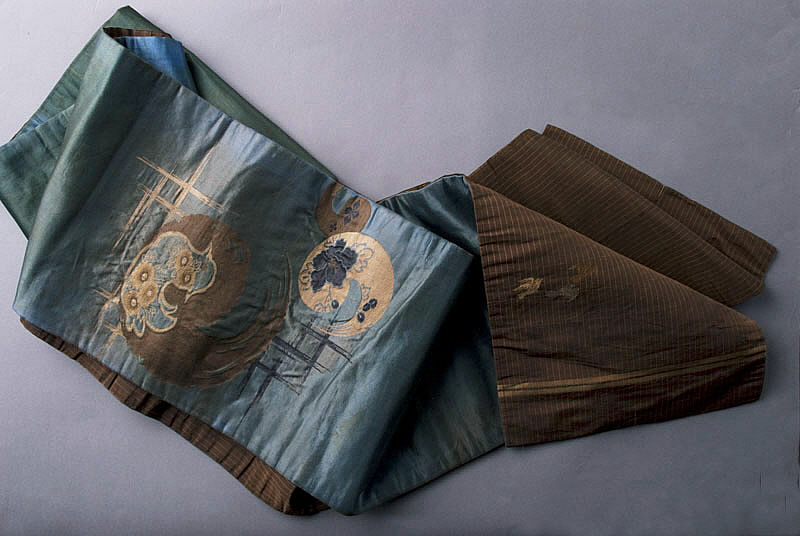
Japanese immigration to Hawai‘i began in 1868—more than 140 years ago.
From Tokyo and Yokohama, seekers of fortune and adventure responded eagerly to the recruiters sent by the sugar industry in Hawai‘i who promised a wage of four dollars a month, plus food, lodging and medical expenses, with boat passage to the Islands and back after the fulfillment of three-year contracts.
In reality, those who came to the Islands became indentured to plantation owners, their dreams of fortune fading into a grim saga of migration, hardship, adaptation and survival.
Food, shelter and clothing: the three necessities of life. For the earliest Japanese immigrants to Hawai‘i, clothes were often the only possessions brought from their homeland, and for women, clothes took on added significance—as precious mementos of a familiar past. Whether it was kimono from their villages, the clothing refashioned from traditional wear in Hawai‘i, or new handmade apparel, these garments were more than simply objects of necessity.
Clothing offered a way to maintain culture, a sense of identity, and a means to express individual creativity and beauty.
Patterns of Migration—A Timeline of Japanese Immigration to Hawai‘i
- 1867-1868: Return to Imperial rule in Japan begins the period of modernization and industrialization known as the Meiji (or “Enlightened”) Restoration.
- 1868: The first Japanese immigrants, known as Gannen Mono, or “First Year of the Meiji Era People,” arrive in Hawai‘i. 153 immigrants include two pregnant women, skilled craftsmen, displaced samurai, coolies and rowdy adventurers addicted to drinking and gambling.
- 1876: Reciprocity Treaty of 1875 between the United States and the Kingdom of Hawai‘i permits the duty-free export of unrefined sugar to the U.S. launching the mass cultivation of sugar and pineapple in Hawai‘i by American businesses. The U.S. also acquires land in the area that will become the Pearl Harbor naval base.
- 1882: Passage of the Chinese Exclusion Act effectively ends the immigration of Chinese laborers to the U.S. and establishes the basis for making non-citizen Asian residents ineligible for naturalization. The anti-Asian climate that results in the exclusion of Chinese labor creates an opening for immigrants from Japan.
- 1885-1894: Famine and a war with China create conditions in Japan that compel peasants and tenant farmers to leave their villages for opportunities abroad. This second wave of immigrants, primarily from Hiroshima, Yamaguchi, Kumamoto and Fukuoka prefectures, leaves a legacy of descendants in Hawai‘i. 28,691 laborers and family members emigrate to the Kingdom of Hawai‘i on three-year government contracts.
- 1893: An armed revolt led by American and European businessmen and sugar plantation owners removes Queen Lili‘uokalani, monarch of the Kingdom of Hawai‘i, establishes a Provisional Government, and proclaims the Republic of Hawai‘i. U.S. President Grover Cleveland declares the action illegal.
- 1894: A third wave of immigration begins when the Japanese government turns emigration over to licensed private companies. They frequently exploit laborers who spend an entire initial contract period paying off debt to the company. 57,000 Japanese arrive in Hawaii during the “Private Contract Period” that lasts until 1900.
- 1898: Congress approves the annexation of Hawai‘i as a U.S. Territory.
- 1900: The first contingent of Okinawans arrives in Hawai‘i. Okinawan emigration to foreign lands is instigated by the take over and incorporation of Okinawa into the Japanese prefectural structure in 1879. Governed by high-level bureaucrats, educators and commercial leaders installed by the Japanese government, and compelled to sell their lands and become tenant farmers, many Okinawan peasants seek better lives abroad. 25,000 men, women and children leave Okinawa for Hawai‘i between 1900 and 1924.
- 1900-1908: United States law prohibits the importation of contract labor. A great many Japanese immigrate to Hawai‘i during these years, known as the “Free Immigration Period,” because immigrants pay passage expenses themselves and can freely choose job destinations. Many are attracted to higher wages offered on the U.S. mainland, creating a large outflow of Japanese from Hawai‘i. 70,000+ Japanese immigrate to Hawai‘i.
- 1908: Protests against cheap labor on the West Coast of the United States lead to the “Gentlemen’s Agreement,” whereby Japan voluntarily restricts emigration to the United States. This initiates a period known as the “Yobiyose Jidai” or “Summoned by Relatives Period,” during which only relatives and former Japanese immigrants returning to Hawai‘i are allowed entry. 61,000 arrivals are recorded.
- 1900-1924: More than half of all the Japanese women who immigrate to Hawai‘i come during these years, referred to as the “Picture Bride Period.” A nakodo (go-between) arranges marriages in absentia by exchanges of letters and photographs of prospective brides and grooms. 20,000+ picture brides mark the transition of a society from that of single male transients to one of permanent resident families.
- 1924: The United States passes the Immigration Act of 1924. The Japanese Exclusion Act as it comes to be known, prohibits the entry of all aliens who are ineligible for citizenship, virtually ending Japanese immigration to the United States.
- 1935: First Hawai‘i statehood bill is introduced in U.S. Congress. Fear of a Japanese electoral majority in Hawai‘i is cited as a reason to deny statehood.
- 1941: Japan launches attack on the U.S. naval base at Pearl Harbor, forcing U.S. entry into World War II. Martial law declared and over a thousand Issei taken into custody. By 1943, more than 10,000 Nisei in Hawai‘i volunteer for 442nd Regimental Combat Team, a segregated U.S. Army regiment that will see heavy action in World War II.
- 1952: The McCarran-Walter Immigration and Nationality Act upholds the quota system of the Immigration Act of 1924, but creates symbolic opportunities for Asian immigration with very limited quota numbers and the right of naturalization.
- 1959: Hawai‘i becomes the 50th state in the Union.
- 1965: Immigration Law abolishes “national origins” as the basis for allocating immigration quotas to various countries, placing Asians on an equal basis with all other immigrants.
- 1979: Barbara Kawakami begins interviewing surviving Issei immigrant workers for her research on plantation clothing.
